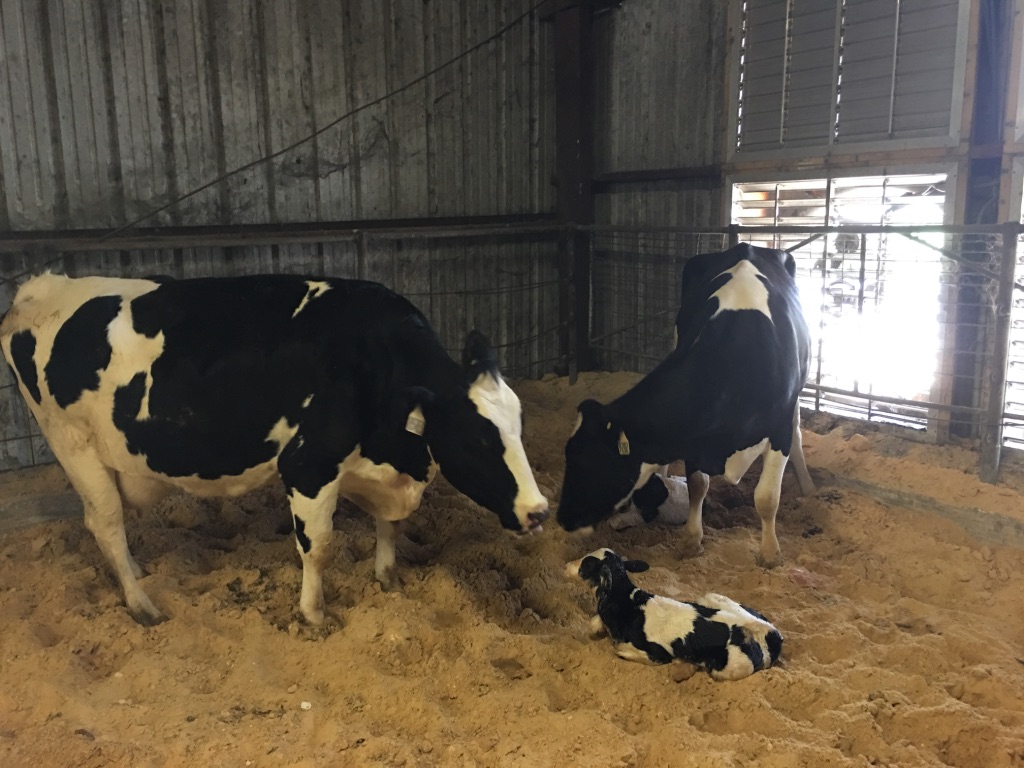Colostrum Management in Dairies

By Heather Smith Thomas
Newborn calves need colostrum to help protect them from diseases they will face in the first weeks of life. Unlike human babies that obtain some of their mother’s antibodies via her bloodstream and the placenta, ruminants like cattle, sheep and goats are born with a naïve immune system. Because of the type of placenta in the dam, the fetus can’t absorb antibodies from her blood. They require colostrum, ingested orally–to provide passive immunity for a few weeks until their own immune system develops.
Rhyannon Moore-Foster, DVM, PhD, Assistant Professor, Livestock Field Service, Colorado State University, has worked with dairies for many years. “Colostrum is the mainstay for a calf to get off to a good start and do well. Newborn calves are dependent on good-quality colostrum from the dam or from other cows in the herd,” she says. Colostrum harvested from the dam or from another fresh cow should be obtained within the first hour, if possible.
One study showed that the IgG concentration in the colostrum decreased by 3.7% each hour that milking was delated after calving, since the cow’s incoming milk begins to dilute the colostrum—which is most concentrated immediately after the birth of her calf. Another study showed that delaying the colostrum harvest for 6, 10 or 14 hours after calving resulted in decreases of 17%, 27% and 33% in IgG concentration, respectively.
The antibodies in colostrum are important, but so are the proteins, fats and sugars. Calves need the fluid and nutrients right away, to give them energy to gain strength and mobility, and to keep warm in cold weather. Colostrum contains a high level of easily-digested fats that provide instant energy and also acts as a laxative to help the calf pass the first bowel moments—the dark meconium that can be fairly firmly packed in the intestines. Benefits from colostrum also include the high levels of nutrients and bioactive compounds that stimulate growth and development in the young calf.
“I usually tell producers and people who ask about a good rule of thumb for the amount of colostrum to feed that typically we recommend feeding colostrum at a rate of 10 to 12% of the calf’s body weight. This is more accurate than saying something like a gallon or 4 liters, because a small Jersey calf won’t need as much as a big Holstein or Holstein-beef cross calf,” says Moore-Foster. Many dairies are now using beef semen on some of their cows—the ones they don’t need replacement heifers from—and those crossbred calves are generally as big as a Holstein calf.
“It’s easy to overload the smaller calves, so we prefer that they simply feed 10 to 12% of their body weight. Most calves will need an amount within the 3 to 4 liter range, but this could be increased or decreased, depending on the calf’s size,” she says.
“Ideally we’d try to get about 2 liters into the newborn calf within the first 4 hours of life, and follow that up with an additional 1 to 2 liters before the calf is 12 hours old, depending on the size of the calf.” In other words, split the amount needed, and give 50% within the first 4 hours (the sooner the better) and the other 50% about 8 hour later.
The other important thing to remember is that quality is as important as timing and quantity. “Some producers struggle with quality as well as quantity, especially some seasons of the year. There may be a period when they have extra colostrum and other periods when they don’t have as much. It is important to test and freeze some of the best if they have extra, to have some on hand during times they may be short.”
She also recommends having some commercial colostrum products on hand, for emergencies. “It’s not ideal, but definitely better than nothing, especially if you run out of colostrum at 3 a.m. in the middle of a snowstorm,” she says.
To check the quality, she generally recommends using a Brix refractometer or some other measuring device. “For the Brix, the cut-off is usually 22%. This can help you differentiate between good colostrum and poor-quality colostrum.” Some is definitely denser, containing more antibodies and nutrients.
“Colostrum from older cows will usually be higher quality than from heifers, if you have to pool colostrum from different age groups, or if you are using frozen colostrum; it’s good to know which cows it came from and what the quality is,” she says.
The calf gets some benefit from colostrum even after he’s a few hours older and the antibodies can no longer be absorbed through the gut lining, due to gut closer. Some of the antibodies can stay in the GI tract and fight pathogens locally. This mucosal immunity is beneficial, and may not be as important in dairy calves as with beef calves that are continuing to suckle their dams and get the rest of the colostrum as it is gradually replaced with regular milk.
“Dairy cows are generally more closely observed than beef cows that may calve out in the field in the middle of the night, and you don’t know how old the calf is or how quickly the calf obtained colostrum, if it is not seen until the next day. With dairy calves that received their first feeding, even if you are past the 12 hour window for the second feeding, it is still worth giving another feeding of colostrum because we don’t know exactly how much of the gut has closed off yet, hindering direct absorption. Some absorption is better than none, and the colostrum has additional benefits as well.”
Some dairies utilize the waste milk (that can’t be put into the bulk tank after the cow calves, until there is no more colostrum in it) to feed older calves. “And if it’s not high enough quality to use as a first feeding of colostrum for a calf, if you are running short, some of this second milking (that still contains some colostrum) might work as a second feeding for young calves,” she says.
“Good colostrum production depends on good nutrition for the cow, and good health, even before her calf is born. Dairy producers need to work with their veterinarian and nutritionist to make sure cows are healthy, with good body weight, and not going through a lot of immune stress before calving,” says Moore-Foster.
“Make sure your vaccination protocol is amenable to good antibody production that will end up in the colostrum. Some dairies are vaccinating their cows only 2 weeks before calving but that’s too close, with not enough time to mount a good immune response. We want to vaccinate 4 to 8 weeks prior to calving to build that immunity,” she says.
Nutrition, seasonality, heat stress, etc. can impact colostrum production. “We have to make sure we are minimizing the adverse things that we can control, and try to set that cow up for success.” The quality of colostrum is very cow-dependent.
One way to monitor your colostrum program and to know if it is working for your calves or not is to check serum total protein levels in the calves, sometime between day 2 and 7 after the calf is born. “Looking at the total protein concentration gives you an indication of whether your colostrum program is adequate,” says Moore-Foster.
“Rather than a pass versus fail, when looking at the results of this testing, it’s more a score of excellent, good, fair or poor. Just because a calf falls into the poor to fair category doesn’t necessarily mean the calf will get sick. Similarly, just because a calf has a really good total protein score (excellent to good) doesn’t mean the calf won’t get sick.” It depends on the pathogen load in that calf’s environment, and exposure, but you definitely want to start off with a high level of antibodies. Good colostrum is your best insurance.
Testing blood levels for serum IgG levels is a good way to monitor your program, however. Calves have historically been defined as having failure of passive transfer if the serum IgG concentration is less than 10 grams per liter when sampled between 24 and 48 hours of age, based on increased mortality risk below this threshold–but recent studies show that reduced sickness in calves is generally associated with higher serum IgG levels. A recent national dairy study reported that 15.6% of calves tested had failure of passive transfer, indicating a need for more efforts to improve colostrum management.
It’s crucial that the cow you select, to utilize colostrum from, is healthy and has no infectious disease that might put a calf at risk, since certain pathogens can be passed along in the milk. “If a dairy is buying a lot of colostrum from another farm, you want to make sure there are no infectious pathogens that could potentially be introduced into your herd. Biosecurity is important; you want a disease-free herd. You might not know that you’ve inadvertently infected a calf until that calf is older and then you’ve introduced that problem into your herd,” she says. If you know your own cows are healthy and disease free, you might want to be cautious about using colostrum from another herd without proper testing.
“The best way to thaw colostrum is in a water bath, with the temperature between 104 and 140 degrees Fahrenheit. It will take approximately 30 minutes to thaw. When fed, you want the colostrum to be at 102 degrees Fahrenheit–a calf’s normal body temperature. Microwaving should be avoided as it can heat the colostrum unevenly and cause destruction of the proteins. Warming colostrum at room temperature is also not recommended because it can take too long and allow bacteria to grow,” she says.
There advantages to bottle-feeding the colostrum versus administering it via esophageal feeder probe. “Benefits of bottle feeding include eliminating the risk of placing the tube in the trachea instead of the esophagus. Some research suggests that calves that are tubed can ingest more colostrum compared to those that are bottle fed. But unless someone on the farm is comfortable placing an esophageal tube it shouldn’t be attempted until they are adequately trained,” says Moore-Foster.
[Dr. Moore-Foster is currently at Colorado State University, teaching students and providing veterinary services for clients. She graduated from Michigan State University vet school in 2013 then went into private practice in rural Michigan before going back for her PhD in comparative medicine, with a focus on mastitis in dairy cattle and employee education for agricultural purposes. After that, she did an internship with a large dairy before going back to a large food animal private practice in Michigan, before moving to Colorado State University in 2020.]




